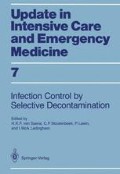Abstract
Nosocomial bacterial infection is a major cause of morbidity and mortality in neonatal special care units. Numerous prospective and cross-sectional studies have investigated the prevalence of nosocomial paediatric infections and the factors causing high infection rates. Studies in North America [1, 2] and in Europe [3] have shown infection rates ranging from 10 to 30% of all admissions. In addition, outbreaks involving specific pathogens may cause higher infection rates over a limited time. In many cases of nosocomial infection, particularly those due to gram-negative bacteria, the problem is increased by antibiotic-resistant pathogens, leading to treatment failures or to the use of antimicrobial agents with narrow efficacy/toxicity ratios in infants.
Access this chapter
Tax calculation will be finalised at checkout
Purchases are for personal use only
Preview
Unable to display preview. Download preview PDF.
References
Hemming VG, Overall JC Jr, Britt MR (1976) Nosocomial infections in a newborn intensive-care unit. N Engl J Med 1310–1316
Jarvis WR (1987) Epidemiology of nosocomial infections in pediatric patients. Pediatr Infect Dis J 6: 344–351
Daschner F (1983) Analysis of bacterial infections in a neonatal intensive care unit. J Hosp Infect 4: 90
Goldmann DA, Leclair J, Macone A (1978) Bacterial colonization of neonates admitted to an intensive care environment. J Pediatr 93: 288–293
Noy JH, Ayliffe GAJ, Linton KB (1974) Antibiotic-resistant gram-negative bacilli in the faeces of neonates. J Med Microbiol 7: 509–520
Datta N (1965) Infectious drug resistance. Brit Med Bull 21: 254–259
Kado CI, Liu S-T (1981) Rapid procedure for detection and isolation of large and small plasmids. J Bacteriol 145: 1365–1373
Amyes SGB (1986) Epidemiology of trimethoprim resistance. J Antimicrob Chemother 18: 215–221
Tenover FC (1986) Studies of antibmicrobial resistance genes using DNA probes. Antimicrob Agents Chemother 29: 721–725
Sanders CC, Sanders WE Jr (1983) Emergence of resistance during therapy with the newer ß-lactam antibiotics: role of inducible ß-lactamases and implications for the future. Rev Infect Dis
Nelson KE, Warren D, Tomasi AM et al (1985) Transmission of neonatal listeriosis in a delivery room. Am J Dis Child 139: 903–905
Fisher MC, Long SS, Roberts EM et al (1981) Pseudomonas maltophilia bacteremia in children undergoing open-heart surgery. JAMA 246: 1571–1574
Goldmann DA (1988) The bacterial flora of neonates in intensive care–monitoring and manipulation. J Hosp Infect 11: 340–351
Sprunt K (1985) Practical use of surveillance for prevention of nosocomial infection. Seminars in Perinatology 9: 47–50
White RD, Townsend TR, Stephens MA, Moxon ER (1981) Are surveillance of resistant enteric bacilli and antimicrobial usage among neonates in a newborn intensive care unit useful? Pediatrics 68: 1–4
Isaacs D, Wilkinson AR, Moxon ER (1987) Surveillance of colonization and late-onset septicaemia in neonates. J Hosp Infect 10: 114–119
Editor information
Editors and Affiliations
Rights and permissions
Copyright information
© 1989 Springer-Verlag Berlin Heidelberg
About this paper
Cite this paper
Shears, P., Leonard, M., Walker, J. (1989). Where and How Does Antimicrobial Resistance Develop in the Critically Ill? Studies in Neonatal Patients. In: van Saene, H.K.F., Stoutenbeek, C.P., Lawin, P., Ledingham, I.M. (eds) Infection Control in Intensive Care Units by Selective Decontamination. Update in Intensive Care and Emergency Medicine, vol 7. Springer, Berlin, Heidelberg. https://doi.org/10.1007/978-3-642-83752-4_18
Download citation
DOI: https://doi.org/10.1007/978-3-642-83752-4_18
Publisher Name: Springer, Berlin, Heidelberg
Print ISBN: 978-3-540-51041-3
Online ISBN: 978-3-642-83752-4
eBook Packages: Springer Book Archive

